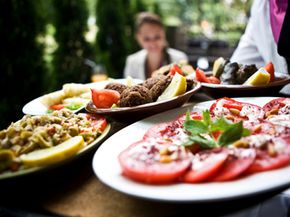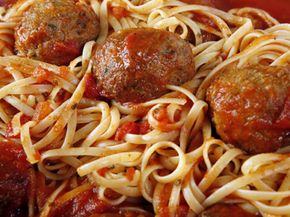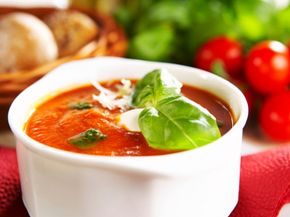“
 “Kid-Friendly Recipes Image Gallery What’s on your list of foolproof comfort foods? See more pictures of kid-friendly recipes.webphotographer/iStockphoto.com
“Kid-Friendly Recipes Image Gallery What’s on your list of foolproof comfort foods? See more pictures of kid-friendly recipes.webphotographer/iStockphoto.com
These five examples of comfort food favorites have some powerful things going for them. They have great flavor, use ingredients that are plentiful, are economical, freeze well, and can be scaled up or down as needed. They also have the advantage of being easy to make, and they contribute some tantalizing aromas to the kitchen. If you’re looking for something to serve for dinner tonight, don’t head to the drive-through; show your creative side by serving one of these offerings instead.
A big part of family life is eating together, and these meals create delectable aromas and delicious flavors that will make mealtime an event. Use your dining table for something other than paying the bills. Invest some time in creating Sunday dinner style meals and serve them any day of the week. Children who eat family meals are more likely to do well in school, steer clear of drugs and maintain healthier lifestyles, so mix up some good memories while you’re making dinner tonight [source: Marino].
While you’re saving a few pennies, you can also explore your creative side. Cooking can be a relaxing pastime that will help reduce your stress level and put you in better control of your diet. Foodies know the value of creative cooking, and these basic menu items can be elegant and complex or classically simple, depending on the occasion. They can also reflect the regional flavors or special ingredients that interest you the most. Try making chili with black beans, or craft a homemade pumpkin soup with cumin and cilantro. You aren’t limited by what’s in the frozen case of your local grocery store if you’re willing to put on an apron and do some chopping. With a little effort — sometimes very little — you can make a unique, hearty meal with all the fixings for a fraction of what it would cost to eat out.
First up, let’s take a look at spaghetti. From coast to coast, this American favorite has been making us feel full and satisfied, even during lean times.
Contents
- Spaghetti
- Slow Cooker Meals
- Macaroni and Cheese
- Soup
- Chili
5. Spaghetti
 “
“ “The question is: meatballs or no meatballs?adlifemarketing/iStockphoto.com
“The question is: meatballs or no meatballs?adlifemarketing/iStockphoto.com
Italian immigrants originally introduced spaghetti to the United States in the late 19th century. Where early Italian versions were less meaty and probably baked, the abundance of meat, a scarce commodity in Italy, distinguished this newer version as an American original.
Franco-American started canning spaghetti as early as the 1890s, and today you can find canned spaghetti as well as dry spaghetti mixes, microwave entrees and frozen dinners in every neighborhood grocery store. There are entire restaurant chains that rely on spaghetti as their signature dish, and whether you like yours chunky or smooth, with whole-wheat noodles or with a few mushrooms thrown in, it’s a good bet that spaghetti in one form or another will be a hit at your house [source: The Nibble].
During times of financial struggle, spaghetti has always been considered a good value. During World War I, when imports of foreign manufactured pasta were stopped, the demand for domestically made pasta soared. During the Great Depression in the early 1930s, spaghetti and other inexpensive entrees, like soup, became staples of the American diet.
Some simple tips will help you make perfect spaghetti every time:
- Use plenty of water to cook dry spaghetti, and make sure that it’s at a rolling boil when you add the noodles. Six quarts (5.67 liters) of water for a pound of pasta is a good ratio.
- Add a teaspoon or two of salt to the water to enhance the flavor.
- Stir spaghetti occasionally as it cooks to keep it from sticking together.
- Read the directions for cooking times, and taste a small piece of spaghetti for doneness before removing it from the heat. It should still taste a little chewy. This is the "al dente" that Italian cooks talk about, and the best way to make sure you’ve got a good, soft but still slightly chewy texture is to taste it.
- Drain pasta thoroughly in a colander, shaking it vigorously to remove excess water.
- Don’t rinse spaghetti pasta; the extra starch sticking to the noodles will help make the sauce thicker. To get the full benefit, mix with sauce immediately after draining.
On the next page, we’ll see what’s simmering in the slow cooker.
4. Slow Cooker Meals
Slow cooked meals have many advantages in the hectic world we live in. You can make them in state-of-the-art appliances that conserve energy. The slow cooking process uses time and low heat to extract flavor from meats and vegetables. With 10 minutes of prep in the morning and a programmable slow cooker, you can have a ready-to-serve dinner waiting for you when you get home.
If you’re watching your wallet, you may be eating fewer porterhouse and rib eye steaks than you used to. Less expensive cuts of meat have less marbling, the speckling of fat that makes meat tender and juicy, but they can still be part of a memorable and satisfying meal. Tougher meats, like chuck, cooked the slow way to release their flavor and soften tough muscle fibers can be as sweetly flavorful as steak. If you’ve been relying on your outdoor grill to prepare meat, it may surprise you to learn that older, tougher cuts have more flavor, both in the muscle and the fat. Not only that, some of the connective tissues in tougher meat release collagen that helps make sauces more satisfying. Those sauces baste the meat as it cooks, and the result is a succulent mouthful that falls off the bone, moist and full of flavor.
The following tips will help you make the best use of your slow cooker the first time and every time you use it:
- If you want to ensure a fast cleanup, coat your slow cooker insert with cooking spray.
- Brown meats in a skillet before adding them to the pot; meats don’t brown in a slow cooker.
- Never try to cook frozen ingredients in a slow cooker. Observe good food safety, and thaw all foods in the refrigerator before cooking.
- Slow cooked meals retain more moisture than their uncovered, stovetop counterparts, so pay close attention to the liquid measurements in recipes. When converting stovetop recipes for use in a slow cooker, cut back on the water. If you need to, you can always add it later.
- Remove food from the slow cooker immediately. Allowing foods to cool in the pot encourages bacterial growth.
On the next page, we’ll indulge in some mac and cheese comfort food.
3. Macaroni and Cheese
Chances are that your children appreciate macaroni and cheese, and you should, too. It’s an inexpensive source of protein that’s easy to make and sure to please. Whether you stick with the packaged varieties, use processed cheese and dried pasta, or want to go gourmet with five cheese creations that are spiced with leeks and sprinkled with pancetta, mac and cheese has something for everyone. In fact, it’s so popular that it made the 10 Foods of the Century list compiled in the 1990s by The Sacramento Bee from the opinions of food professionals evaluating dishes that most clearly represented American cooking [source: The Nibbler].
If you plan on cooking some mac and cheese at your house, remember:
- Elbow macaroni is a great accompaniment to this cheese dish. It holds the thick gooey sauce perfectly, and will even let some dribble into the hole in the center.
- The most popular cheeses for macaroni and cheese are American and cheddar. Cheese food preparations, like Velveeta, are also popular.
- If you’re having problems with your cheddar cheese separating, try mixing it with another cheese, like American, or with a cheese food. If you’re a cheddar purist, melt your cheese over low heat.
- Want to add to the nutritional value of your kids’ favorite meal? Try using whole-wheat pasta. Under all that cheese, who’ll know?
- Spice up your cheese with some . . .spices. Freshly ground nutmeg, red pepper or a little thyme will add some pep to your recipe. Need even more flavor? Try adding grated Parmesan cheese on top.
Coming up next, a ladleful of soup.
Kraft Macaroni & Cheese
In 1937, during its first year in production, Kraft Foods marketed its grated cheese and dried pasta product for 19 cents. It sold nine million boxes [source: Vital Statistics].
2. Soup
 “
“ “You can be totally creative when you make your own soup.ShyMan/iStockphoto.com
“You can be totally creative when you make your own soup.ShyMan/iStockphoto.com
Soup has been around since man could boil water. It can stretch a budget by making the most of limited ingredients and quantities. It can also showcase the bounty of a good harvest from either the ocean or the field. Soup can stand alone at the dinner table or become a tantalizing first course in a lavish meal.
During tough times, it’s been a means of filling hungry bellies and fed hundreds of thousands during the Great Depression in makeshift cafeterias that were affectionately called soup kitchens.
In challenging economic times, soup is a good way to stretch your food dollar. Soup can be a hearty, nutritious meal. If you make it yourself, it can even be an opportunity to let your creative juices flow.
There are some things to keep in mind when making soup. Always start with flavorful stock. You may want to go with the convenience of canned stock, but there’s nothing like making your own from scratch. For the best results, use bones simmered in water for four to six hours or overnight. Add aromatics like onions, carrots and celery. Herbs like thyme, bay leaf and parsley are good choices too. These ingredients will add complex, savory goodness to the broth and can be discarded later.
Imagine a big pot of soup cooking on the stove, filling the house with the aroma of chicken, tomato, or clams in a creamy sauce. Remember, when you make soup, you control the ingredients. Want less fat? Cool your broth overnight in the refrigerator, and skim the fat off the top the next morning. Want it thicker without adding flour? Try mashing some potato or beans. The starch will help thicken the broth.
If you’re not comfortable with cooking soup from scratch, there are prepared mixes that will handle the spices and thickeners; you just add meat and water. And you can always use a condensed soup, like cream of mushroom or tomato, as a base for your soup creation.
Whether you use a mix, condensed canned preparation or create something wonderful yourself, soup is a traditional comfort food that’s a foolproof winner at mealtime. Add some crusty bread, and you have a meal that has sustained families in good times and bad for centuries.
On the next page, we’ll heat things up with a pot of chili.
1. Chili
Although most things about chili are up for debate — including its origins and how it should be made — there’s no doubt that it’s a dish that has captured the imagination of American cooks from coast to coast. The amount of heat and what types of pepper to use are often disputed, and that’s probably the real beauty of chili. It’s a dish that inspires deep feelings, with thousands of popular recipes.
With so much chili goodness out there, you’re bound to find a style that suits you. Have a vegetarian in your house? Try making a meatless chili, and then serve meat on the side for other members of the family. They can mix the meat in their portion, and everyone gets what he or she wants.
If you’re planning on trying your hand at fixing up a pot of chili, keep these things in mind:
- The heat in chili peppers is mostly in the veins, the white inner part of the fruit, and in the seeds.
- Wash your hands thoroughly after chopping chili peppers.
- Different peppers heat different parts of the palate, and using a variety can enhance the taste of chili by creating levels of heat.
- Designer chili can be interesting and easy to make. Indulge your love for new foods and experiment. Try using a different variety of beans, or add new flavor to your chili with beer, honey, liquid smoke or tomatillos. Look in your cupboards for something pungent, and walk on the wild side. This is the time to see what your spice rack has to offer.
- Make the most of your dried peppers, cinnamon, allspice, and cumin by grinding them fresh for your chili.
- Want a chili that will suit the whole family? Reduce the heat by adding the bulk of the hot peppers to only a quarter or a third of the recipe. That way everyone can pick a temperature that suits him or her.
Chili is economical to make, and you can double or triple recipes easily. Freeze the extra, and serve it on the next cold evening. There’s nothing like a bowl of chili to make you feel warm all over.
Want to learn more about sure-fire meals that will be a hit at your house? Check the links on the next page for interesting information and recipes.
The Scoville Organoleptic Test
The heat in chili peppers used to be measured by a taste test developed by Wilbur Scoville in 1912. Although more accurate scientific methods, like high-pressure liquid chromatography, are used today, the Scoville Test is still referred to when talking about the concentrations of capsaicinoids, the hot stuff, in hot peppers [source: Chili World].
Lots More Information
Related HowStuffWorks Articles
- How to Cook Light on a Budget
- How to Have a Picnic
- How Black Angus Works
- How Campfire Cooking Works
- How the Raw Food Diet Works
More Great Links
- Pasta Shapes
Sources
- Chili World. "Measuring Chilli Heat." Undated. 2/4/09. http://www.chilliworld.com/FactFile/Measuring_Chilli_Heat.asp
- Consumer Reports Blog. " Q&A: Can an oven’s slow-cook mode do as good a job as a slow cooker?" 11/19/08.1/27/09. http://blogs.consumerreports.org/home/2008/11/slow-cookers.html?resultPageIndex=1&resultIndex=4&searchTerm=slow%20cookers
- Consumer Reports. "Soup Sales are a Sign of the Times." 11/22/08.2/1/09. http://blogs.consumerreports.org/home/2008/11/campbells-soup.html?resultPageIndex=1&resultIndex=1&searchTerm=soup
- Editors of Easy Home Cooking Magazine. "Slow Cooker Questions." Undated. 1/30/09. https://recipes.howstuffworks.com/slow-cooker-questions.htm
- Editors of Easy Home Cooking Magazine. "Soup Tips." Undated. 1/25/09. https://recipes.howstuffworks.com/soup-tips.htm
- Food Timeline. "Chili Con Carne." Undated. 2/3/09. http://www.foodtimeline.org/foodmexican.html#chiliconcarne
- How To Cook Gourmet. "Cooking Meats." Undated. 1/1/09. http://www.how-to-cook-gourmet.com/cookingmeats.html
- Howstuffworks.com. "Pasta Recipes." Undated. 1/4/09. https://recipes.howstuffworks.com/pasta-recipes-channel.htm
- Kummer, Corby. "Pasta." The Atlantic. 7/86. 2/1/09. http://www.theatlantic.com/doc/198607/pasta
- Lipman, Brian, M.D. "When Bad Food Happens." Undated. 1/31/09. http://www.consumerreports.org/health/healthy-living/diet-nutrition/healthy-foods/when-bad-food-happens-9-06/overview/0609_bad-food-happens.htm
- Macaroni Cheese Recipes."Macaroni and Cheese Gets a Makeover." Undated. 2/1/09. http://www.macaronicheeserecipes.com/Macaroni-and-Cheese-Gets-a-Makeover.htm
- Macaroni Cheese Recipes. "Macaroni and Cheese has an Interesting History." Undated. 2/1/09. http://www.macaronicheeserecipes.com/Macaroni-and-Cheese-History.htm
- Marino, Martha MA, RD, CD and Sue Butkus, PhD, RD. "Background: Research on Family Meals." Washington State University. Undated. 2/3/09. http://nutrition.wsu.edu/ebet/background.html
- National Pasta Association. "Pasta Shapes." Undated. 1/29/09. http://www.ilovepasta.org/shapes.html
- Online Gourmet Foods. "The History of Spaghetti." Undated. 1/30/09. http://www.online-gourmet-foods.com/history-of-spaghetti.html
- Phillips, Kyle. "Pasta Shapes Glossary." Undated. 1/26/09. http://italianfood.about.com/od/pastabasics/a/aa032401.htm
- Stradley, Linda. " History of Chili, Chili Con Carne." What’s Cooking America. Undated. 2/3/09. http://whatscookingamerica.net/History/Chili/ChiliHistory.htm
- The Nibble. "The History of Pasta." Undated. 1/29/09. http://www.thenibble.com/REVIEWS/MAIN/pastas/history-of-pasta.asp
- Vital Statistics. "Kaft Macaroni and Cheese." Undated. 1/29/09. http://www.vitalstatistics.info/stat2.asp?id=17502&cid=21&scid=674
- What’s Cooking America. " Pasta Hints and Tips – How To Cook Pasta Properly." Undated. 1/29/09. http://whatscookingamerica.net/Pasta_Rice_Main/pasta.htm
- Wright, Clifford A. "History of Macaroni." Undated. 1/31/09. http://www.cliffordawright.com/caw/food/entries/display.php/id/50/
- Wright, Clifford A. "Origin of Macaroni and Cheese." Undated. 1/31/09. http://www.cliffordawright.com/caw/food/entries/display.php/topic_id/16/id/105/


